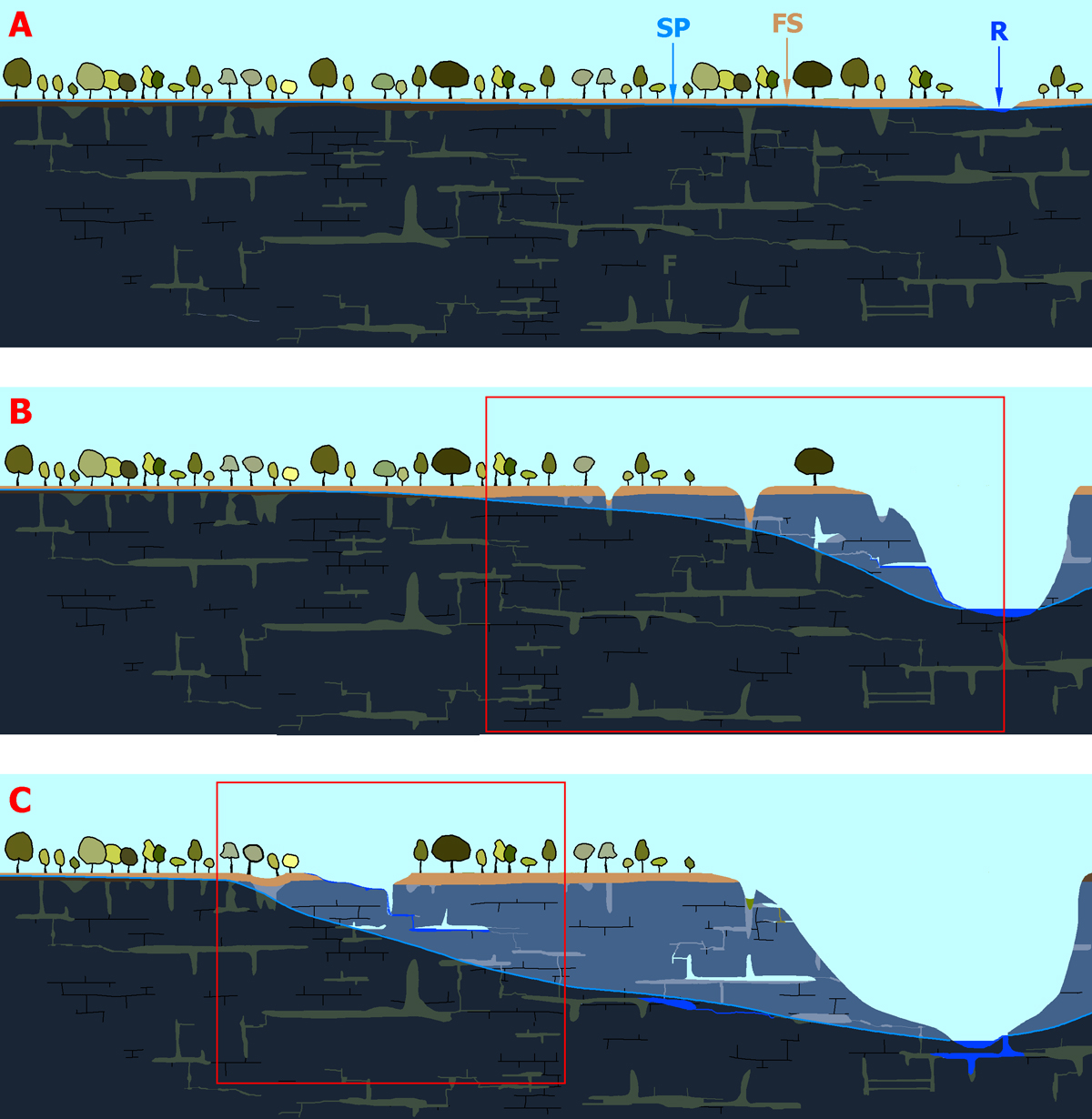Fig. 17a

Download original image
Schéma évolutif d’un massif karstifié par fantômisation. En A, un massif calcaire aplani supporte une formation superficielle (formation transgressive, zone profondément altérée, FS) qui est couverte d’une forêt. La rivière (R) qui impose le niveau de base et, donc, la surface piézométrique de l’aquifère (SP) est peu imprimée dans le paysage. Le potentiel hydrodynamique est faible ce qui entraîne des circulations souterraines très lentes. Suivant ce qui a été mis en évidence dans les paragraphes précédents, seule l’altération chimique agit, à l’exclusion de toute érosion mécanique (période biostasique). Le massif se fantômise (F, zones gris-vert). L’altération, suivant les lignes de courant, profite de toutes les fractures et des strates plus perméables pour transformer la roche mère en fantôme de roche. La distribution géométrique de ces fantômes n’est pas dictée par l’écoulement mais par l’allure des zones à perméabilité initiale plus forte. En B, le massif s’étant soulevé, la rivière s’est incisée et a abaissé la surface piézométrique dans sa zone d’influence. Le cadre rouge détaille les phénomènes proches du versant (Fig. 17b : vidange de fantômes de roche, résurgence, formation de puits en surface. L’allure de la surface piézométrique est ici purement indicative et dépend de la distribution de la perméabilité au sein du massif fantômisé. En C, l’incision fluviatile s’est accentuée. Le recoupement d’un fantôme de roche profond a conduit à la formation d’une source vauclusienne. Un certain volume de l’altérite résiduelle a été érodé (exemple des sources de la Touvre, en Charente). Le cadre rouge détaille des phénomènes en amont du système (Fig. 17c) : tassement et érosion de l’altérite sur le parcours d’une circulation souterraine, perte, ouverture de grottes.
Evolution of a karstified massif by the ghostrock process. In A, a limestone massif is covered by an overburden formation (transgressive formation, deeply weathered zone, FS) under a tropical forest. The river R is very weakly hollowed. The water table is thus very superficial. The hydrodynamical potential is weak; the underground flows are very slow. It is a biostasy phase with an intense chemical weathering without the mechanical erosion. The ghostrock karstification happened (F, grey-green areas). The water goes through the opened joints or strata: the initial permeability ways to transform the bedrock in ghostrocks. The geometry of the weathered areas is not dependent from the current lines but by the areas with greater initial permeability. In B, the massif is in surrection and the rivers are sinking. The water table is going down in the influence areas of the rivers. Red box details the phenomena which are in neighbor of the slope (Fig. 17b): emptying of the ghostrock by erosion of the residual alterite, resurgence, pit genesis at the surface. The appearance of the water table is purely indicative and depends on the geometry of the permeability into the rock massif. In C, the river incision grows. The intersection of a deep ghostrock conducts to the formation of a Vauclusian spring. More and more volumes of the residual alterite are eroded. The red box details the upper system phenomena (Fig. 17c): subsidence, collapse, erosion of the residual alterite along the course of an underground river, swallow holes, opening of caves.
Current usage metrics show cumulative count of Article Views (full-text article views including HTML views, PDF and ePub downloads, according to the available data) and Abstracts Views on Vision4Press platform.
Data correspond to usage on the plateform after 2015. The current usage metrics is available 48-96 hours after online publication and is updated daily on week days.
Initial download of the metrics may take a while.




